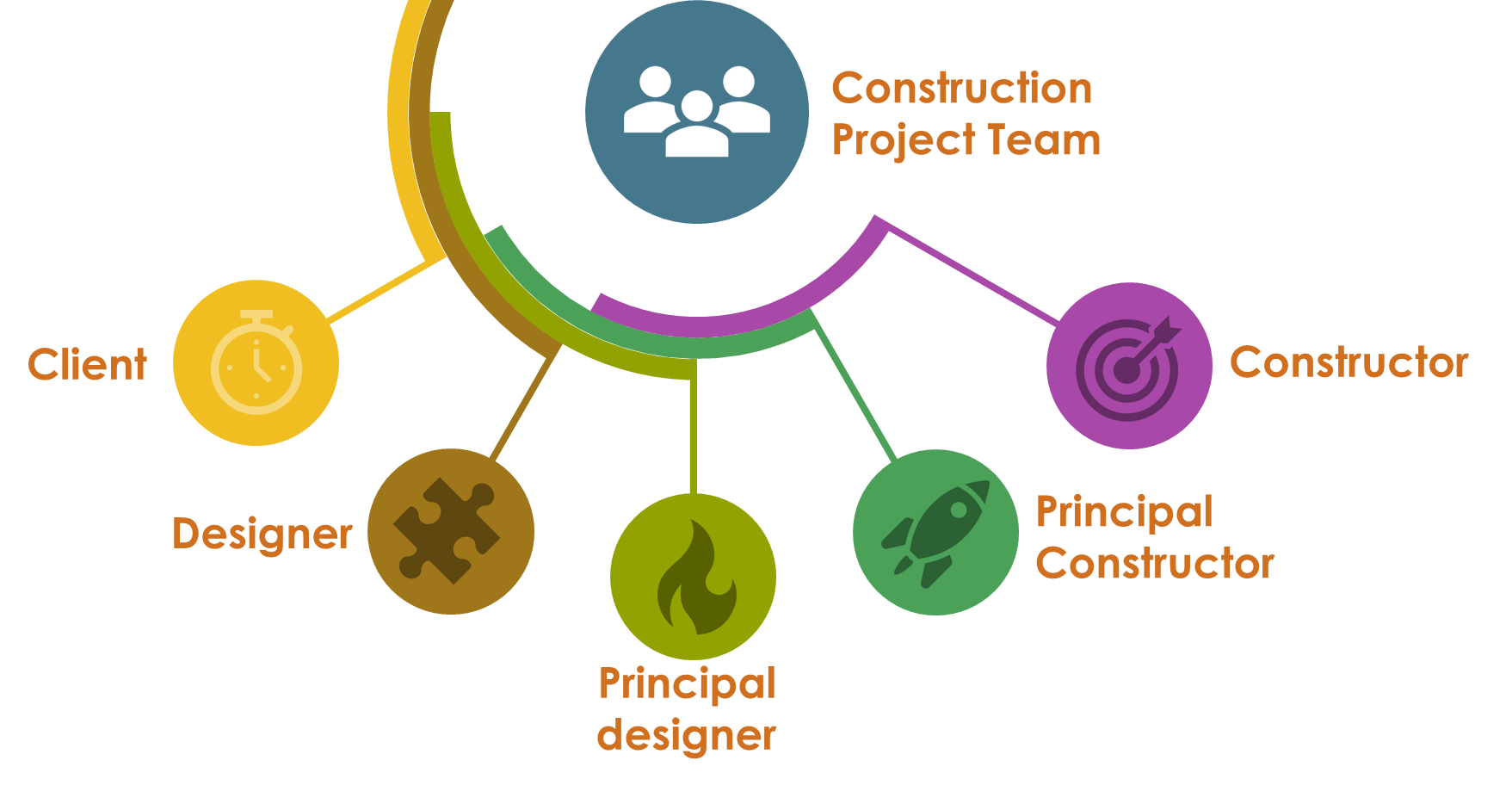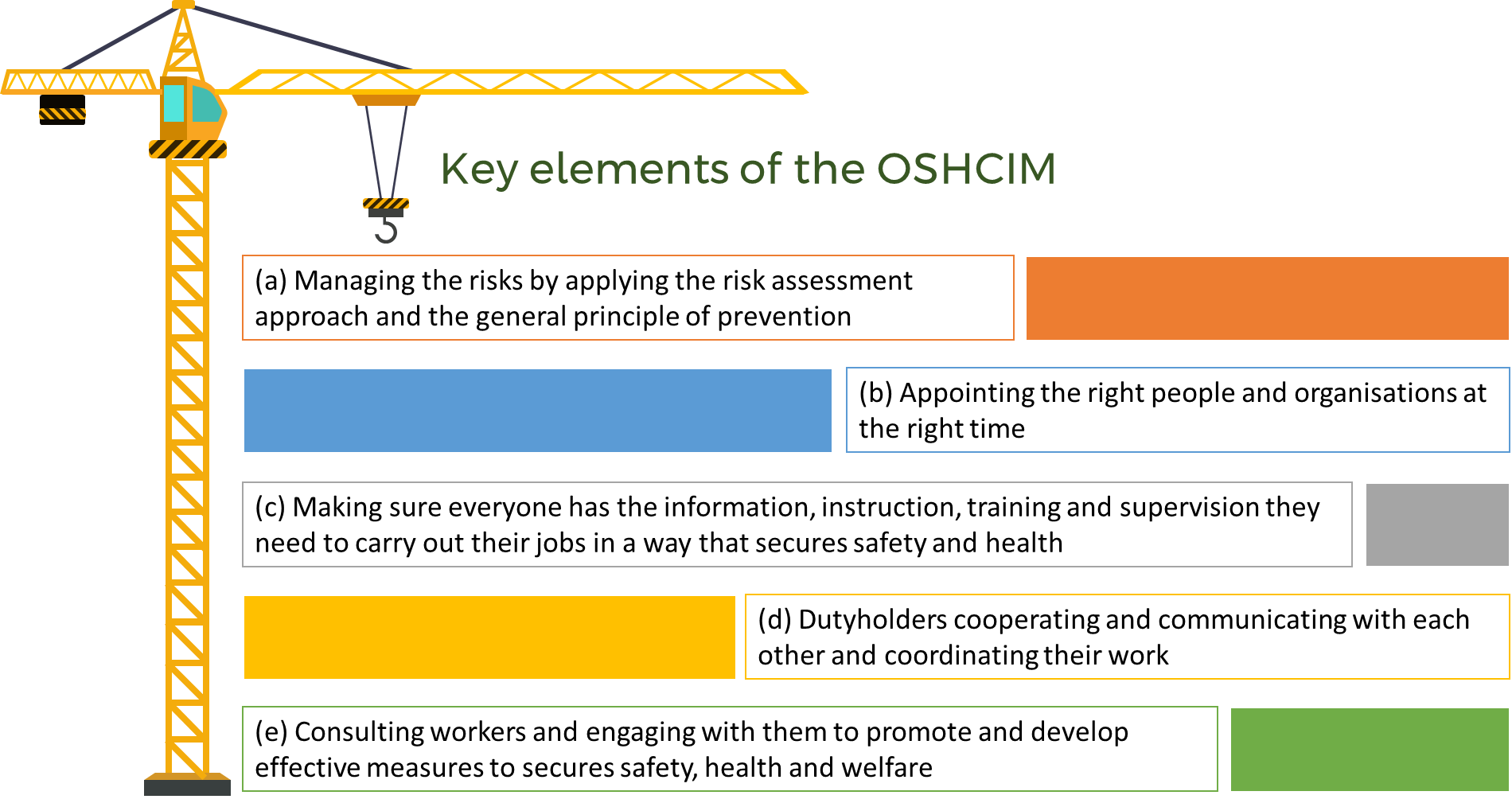OSHCIM
Introduction
1 Managing occupational safety and health risks at the planning and design stage is often more effective, easier to sustain and cheaper to do than making changes later when the hazards become real risks in the workplace. The Guidelines on Occupational Safety and Health in Construction Industry (Management) (OSHCIM) provides practical guidance to the client, designer and contractor on the management of safety, health and welfare when carrying out construction projects1 of a structure2 .
2 The OSHCIM Guidelines is for people with legal duties (who conduct business or undertaking) under the Occupational Safety and Health Act and the Factories and Machinery Act. These include client, designer and contractor as shown in Figure 1. It explains what they must or should do to comply with the law and recommends duties to them in order to manage their projects. Any actions taken should always be proportionate to the risks in the construction project.

Figure 1. Key duty holders in OSHCIM Guidelines are person who involved in construction project team.
3 Generally, responsibility for occupational safety and health in construction should be shared among all stakeholders in the industry’s supply chain. Stakeholders such as client, designer and contractor should work together to design OSH hazards out of the construction industry’s processes and products. By working together, they should identify and eliminate or reduce, as far as is reasonably practicable3 , all foreseeable design risks to safety or health of any person4.
4 Under the OSHA, organisations or individuals can concurrently be one or more duty holder for a project or workplace. Duty holder can also have more than one duty. Each duty holder must comply with that duty to the standard required by the Act even if another duty holder has the same duty.
5 Duty holder must perform his or her duties and cooperate with other duty holders to perform their duties, and promote safe execution of construction and maintenance works so that buildings and structures can be safe workplaces.
Key Elements
6 The OSHCIM are based on five key elements as depicted in Figure 2.

Figure 2. Key elements of OSHCIM Guidelines.
Risk management approach and general principles of prevention
7 These set out the principles duty holders should use in their approach to identifying the measures they should take to control the OSH risks in a particular project. A risk management process is a systematic way of making a workplace as safe as possible and it should also be used as part of the design process. It involves the hazard identification, risk assessment, risk control and review control measures.
8 The general principles of prevention can be summarised as:
(a) avoid risks where possible;
(b) evaluate those risks that cannot be avoided; and
(c) put in place proportionate measures that control them at source.
9 OSHCIM recommends designers, principal designers, principal contractors and contractors to take account of the principles in carrying out their duties. Applying this principle at the planning and design stage will enable the client, designer and contractor to integrate control measures early in the design process to avoid or, if this is reasonably practicable, minimise risks to safety and health throughout the life of the structure being designed.
10 Designing for safety of a structure should always be part of a wider set of design objectives, including practicability, aesthetics, cost and functionality. These sometimes competing objectives need to be balanced in a manner that does not compromise the safety and health of those who work on or use the structure over its life. General guidance on the risk management process is available in the Guidelines for Hazard Identification, Risk Assessment and Risk Control (HIRARC).
Appointing the right organisations and people at the right time
11 Appointing the right organisations and individuals to complete a particular project is fundamental to its success, including safety and health performance.
Appointing designers and contractors
12 Anyone responsible for appointing designers (including principal designers) or contractors (including principal contractors) to work on a project should ensure that those appointed have the skills, knowledge and experience to carry out the work in a way that secures safety and health. If those appointed are an organisation, they should also have the appropriate organisational capability. Those making the appointments should establish that those they appoint have these qualities before appointing them. Similarly, any designers or contractors seeking appointment as individuals should ensure they have the necessary skills, knowledge and experience.
13 Duty holders should be appointed at the right time. For example, clients should appoint principal designers and principal contractors as soon as practicable and before the start of the construction phase, so they have enough time to carry out their duties to plan and manage the pre-construction5 and construction phases respectively.
Contractors appointing anyone for work on a construction site
14 When contractors appoint anyone to carry out work on a construction site, they should make sure that those they appoint have, or are in the process of gaining, the right skills, knowledge, training and experience. Not everyone will have these qualities and, if they do not, appointments should be made on the basis that they are capable of gaining them.
Supervision, instructions and information
15 The level of supervision, instructions and information required will depend on the risks involved in the project and the level of skills, knowledge, training and experience of the workforce. Contractors (including principal contractors) should make sure supervision is effective and suitable6 site inductions are provided along with other information – such as the procedures to be followed in the event of serious and imminent danger to safety and health.
Cooperating, communicating and coordinating
16 Duty holders should cooperate with each other and coordinate their work to ensure safety and health. They should also communicate with each other to make sure everyone understands the risks and the measures to control those risks. For example, through regular dialogue between the client, the principal designer and principal contractor to ensure they have the time and resources to plan, manage, monitor and coordinate the pre-construction and construction phases.
Consulting and engaging with workers
17 Workplaces where workers are consulted and engaged in decisions about safety and health measures are safer and healthier. Consultation about safety and health is two-way. It involves giving information to workers, listening to them and taking account of what they say before decisions are made by the duty holder. For example, hold meetings before work starts to discuss the work planned for the day, identify risks and agree appropriate control measures. Involving workers helps those responsible for safety and health to manage it in a practical way by:
(a) helping spot workplace risks and knowing what to do about them;
(b) making sure safety and health controls are appropriate;
(c) increasing the level of commitment to working in a safe and healthy way.
18 Consultation is a legal requirement. Workers should be consulted at the right time. The Occupational Safety and Health (Safety and Health Committee) Regulations and the Factories and Machinery (Building Operations and Works of Engineering Construction) (Safety) Regulations require employers to consult their workforce and sub-contractors about safety and health, either direct with workers or through elected representatives.
19 A safe workplace is more easily achieved when people involved at the design stage communicate with each other about potential risks and work together to find solutions. By drawing on the knowledge and experience of other people, including workers, more informed decisions can be made about how the building or structure can be designed to eliminate or minimise risks.
Key Duty Holders
20 The OSHCIM Guidelines suggest that the responsibilities for managing and controlling risks to every person involved in every phase of construction project. Figure 1 shows key duty holders in the OSHCIM Guidelines, who are also person involved in construction project team.
1Project means a project which includes or is intended to include construction works and include all planning, design, management or other works involved in a project until the end of the construction phase.
2Structures are defined as any permanent or temporary structures, which also include any part of the structure and any product, or mechanical or electrical system intended for the structure.
3Reasonably practicable means that the degree of risk in a particular situation can be balanced against the time, trouble, cost and physical difficulty of taking measures to avoid the risk. An action is considered to be practicable when it is capable of being done. To decide if an action is reasonable, one has to consider: (a) the severity of any injury or harm to health that may occur; (b) the degree of risk (or likelihood) of that injury or harm occurring; (c) how much is known about the hazard and ways of eliminating, reducing or controlling it; and (d) the availability, suitability and cost of the safeguards.
4Person is defined as anyone: (a) carrying out or liable to be affected by construction work for the structure; or (b) working in a completed building or structure as a workplace including an individual who maintains or cleans the structure, or anything in or on the structure.
5Pre-construction phase means any period of time during which design or preparatory work is carried out for a project and may continue during the construction phase.
6The test of suitability will include an assessment of sufficiency of available time and other resources, past experience of similar projects, and the experience and qualifications of the employees.














